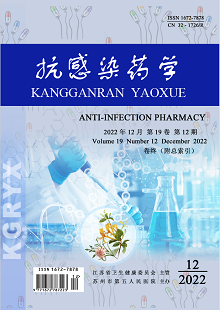XIAO Feng-yan, WANG Jian-feng, JIANG Ming-yu
Objective: To investigate the risk factors and etiological characteristics of nosocomial infection in patients in the Department of Cardiovascular Medicine of the hospital, so as to provide reference for the prevention and treatment of nosocomial infection in such patients. Methods: A total of 600 patients with cardiovascular diseases admitted to the Department of Cardiovascular Medicine of Jishui People's Hospital from May 2019 to February 2021 were chosen as the subjects, and their information and data such as age, gender, underlying diseases, medication history, hospitalization history and etiological examination results were collected to analyze the risk factors and etiological characteristics of nosocomial infection in the patients. Results: Among the 600 patients with cardiovascular diseases, 169 cases had nosocomial infection, with the infection rate of 28.17%. A total of 192 strains of pathogenic bacteria were detected from the specimens of 169 patients with nosocomial infection, including 112 strains of Gram-negative bacteria (58.33%, mainly Klebsiella pneumoniae and Acinetobacter baumannii), 36 strains of Gram-positive bacteria (18.75%, mainly Staphylococcus aureus) and 44 strains of fungi (22.92%, mainly Candida albicans). The antimicrobial susceptibility testing showed that the resistance rates of Klebsiella pneumoniae and Acinetobacter baumannii to amikacin, meropenem and imipenem were low (less than 10.00%); the resistance rate of Staphylococcus aureus to vancomycin and teicoplanin was 0.00%; the resistance rate of Candida albicans to itraconazole, caspofungin and micafungin was low (less than 10.00%). The results of regression analysis showed that the patient's age, use of antacids or not, prophylactic use of antibacterial drugs or not, with or without underlying diseases, and hospitalization for many times or for a long time or not were correlated with the occurrence of nosocomial infection in patients with cardiovascular diseases (P<0.05 ). Among them, age of 60 years old and more, use of antacids, prophylactic use of antibacterial drugs, with underlying diseases and hospitalization for many times or for a long time were the independent risk factors for nosocomial infection (P<0.05). Conclusion: There is a high risk of nosocomial infection in inpatients in the Department of Cardiovascular Medicine of the hospital. Gram-negative bacteria are the main pathogens, but there are differences in the drug resistance characteristics of different pathogens. Antibacterial drugs should be selected rationally according to the results of the antimicrobial susceptibility testing in clinical practice, to improve the accuracy of treatment; in addition, the occurrence of nosocomial infection is closely correlated to the patient's age, underlying disease, medication use and hospitalization status. It is necessary to strengthen the clinical management and monitoring for high-risk patients to reduce the occurrence of nosocomial infection.
